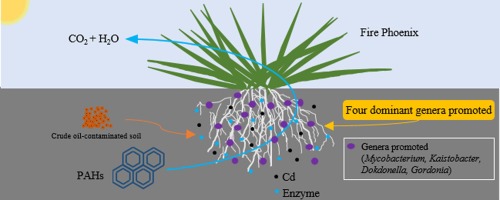当前位置:
X-MOL 学术
›
Environ. Int.
›
论文详情
Our official English website, www.x-mol.net, welcomes your
feedback! (Note: you will need to create a separate account there.)
Fire Phoenix facilitates phytoremediation of PAH-Cd co-contaminated soil through promotion of beneficial rhizosphere bacterial communities.
Environment International ( IF 10.3 ) Pub Date : 2019-12-26 , DOI: 10.1016/j.envint.2019.105421 Yuanyuan Dai 1 , Rui Liu 2 , Yuemei Zhou 2 , Na Li 1 , Liqun Hou 1 , Qiang Ma 2 , Bin Gao 3
Environment International ( IF 10.3 ) Pub Date : 2019-12-26 , DOI: 10.1016/j.envint.2019.105421 Yuanyuan Dai 1 , Rui Liu 2 , Yuemei Zhou 2 , Na Li 1 , Liqun Hou 1 , Qiang Ma 2 , Bin Gao 3
Affiliation

|
Pot experiments were conducted in a growth chamber to evaluate the phytoremediation efficiency and rhizosphere regulation mechanism of Fire Phoenix (a mixture of Festuca L.) in polycyclic aromatic hydrocarbon-cadmium (PAH-Cd) co-contaminated soils. Plant biomass, removal rates of PAHs and Cd, soil enzyme activity, and soil bacterial community were determined. After 150 days of planting, the removal rates of the total 4 PAHs and Cd reached 64.57% and 40.93% in co-contaminated soils with low-PAH (104.79-144.87 mg·kg-1), and 68.29% and 25.40% in co-contaminated soils with high-PAH (169.17-197.44 mg·kg-1), respectively. The polyphenol oxidase (PPO) activity decreased in soils having Fire Phoenix, while the dehydrogenase (DHO) activity increased as the changes of DHO activity had a strong positive correlation with the removal rates of PAHs and Cd in the low-PAH soils (r = 0.862 (P < 0.006) and 0.913 (P < 0.002), respectively). Meanwhile, successional changes in the bacterial communities were detected using high-throughput 454 Gs-FLX pyrosequencing of the 16S rRNA, and these changes were especially apparent for the co-contaminated soils with the low PAH concentration. The Fire Phoenix could promote the growth of Mycobacterium, Dokdonella, Gordonia and Kaistobacter, which played important roles in PAHs degradation or Cd dissipation. These results indicated that Fire Phoenix could effectively motivate the soil enzyme and bacterial community and enhance the potential for phytoremediation of PAH-Cd co-contaminated soils.
中文翻译:

火凤凰通过促进有益的根际细菌群落,促进了PAH-Cd共污染土壤的植物修复。
在生长室中进行盆栽试验,以评估多环芳烃-镉(PAH-Cd)共污染土壤中火凤凰(Festuca L.的混合物)的植物修复效率和根际调节机制。测定植物生物量,多环芳烃和镉的去除率,土壤酶活性和土壤细菌群落。种植150天后,在低PAH(104.79-144.87 mg·kg-1)的共污染土壤中,总4种PAHs和Cd的去除率分别达到了64.57%和40.93%,在Co-土壤中的去除率分别为68.29%和25.40%高PAH(169.17-197.44 mg·kg-1)污染土壤。具有火凤凰的土壤中的多酚氧化酶(PPO)活性降低,而随着DHO活性的变化与低PAH土壤中PAHs和Cd的去除率有极强的正相关性,脱氢酶(DHO)的活性增加(r = 0.862(P <0.006)和0.913(P <0.002),分别)。同时,使用16S rRNA的高通量454 Gs-FLX焦测序技术检测到细菌群落的连续变化,这些变化在PAH浓度低的共污染土壤中尤为明显。火凤凰可以促进分枝杆菌,十二指肠,戈登尼亚杆菌和凯斯特细菌的生长,它们在PAHs降解或Cd耗散中起重要作用。这些结果表明,Fire Phoenix可以有效地激发土壤酶和细菌群落,并增强PAH-Cd共污染土壤的植物修复潜力。
更新日期:2019-12-27
中文翻译:

火凤凰通过促进有益的根际细菌群落,促进了PAH-Cd共污染土壤的植物修复。
在生长室中进行盆栽试验,以评估多环芳烃-镉(PAH-Cd)共污染土壤中火凤凰(Festuca L.的混合物)的植物修复效率和根际调节机制。测定植物生物量,多环芳烃和镉的去除率,土壤酶活性和土壤细菌群落。种植150天后,在低PAH(104.79-144.87 mg·kg-1)的共污染土壤中,总4种PAHs和Cd的去除率分别达到了64.57%和40.93%,在Co-土壤中的去除率分别为68.29%和25.40%高PAH(169.17-197.44 mg·kg-1)污染土壤。具有火凤凰的土壤中的多酚氧化酶(PPO)活性降低,而随着DHO活性的变化与低PAH土壤中PAHs和Cd的去除率有极强的正相关性,脱氢酶(DHO)的活性增加(r = 0.862(P <0.006)和0.913(P <0.002),分别)。同时,使用16S rRNA的高通量454 Gs-FLX焦测序技术检测到细菌群落的连续变化,这些变化在PAH浓度低的共污染土壤中尤为明显。火凤凰可以促进分枝杆菌,十二指肠,戈登尼亚杆菌和凯斯特细菌的生长,它们在PAHs降解或Cd耗散中起重要作用。这些结果表明,Fire Phoenix可以有效地激发土壤酶和细菌群落,并增强PAH-Cd共污染土壤的植物修复潜力。











































 京公网安备 11010802027423号
京公网安备 11010802027423号